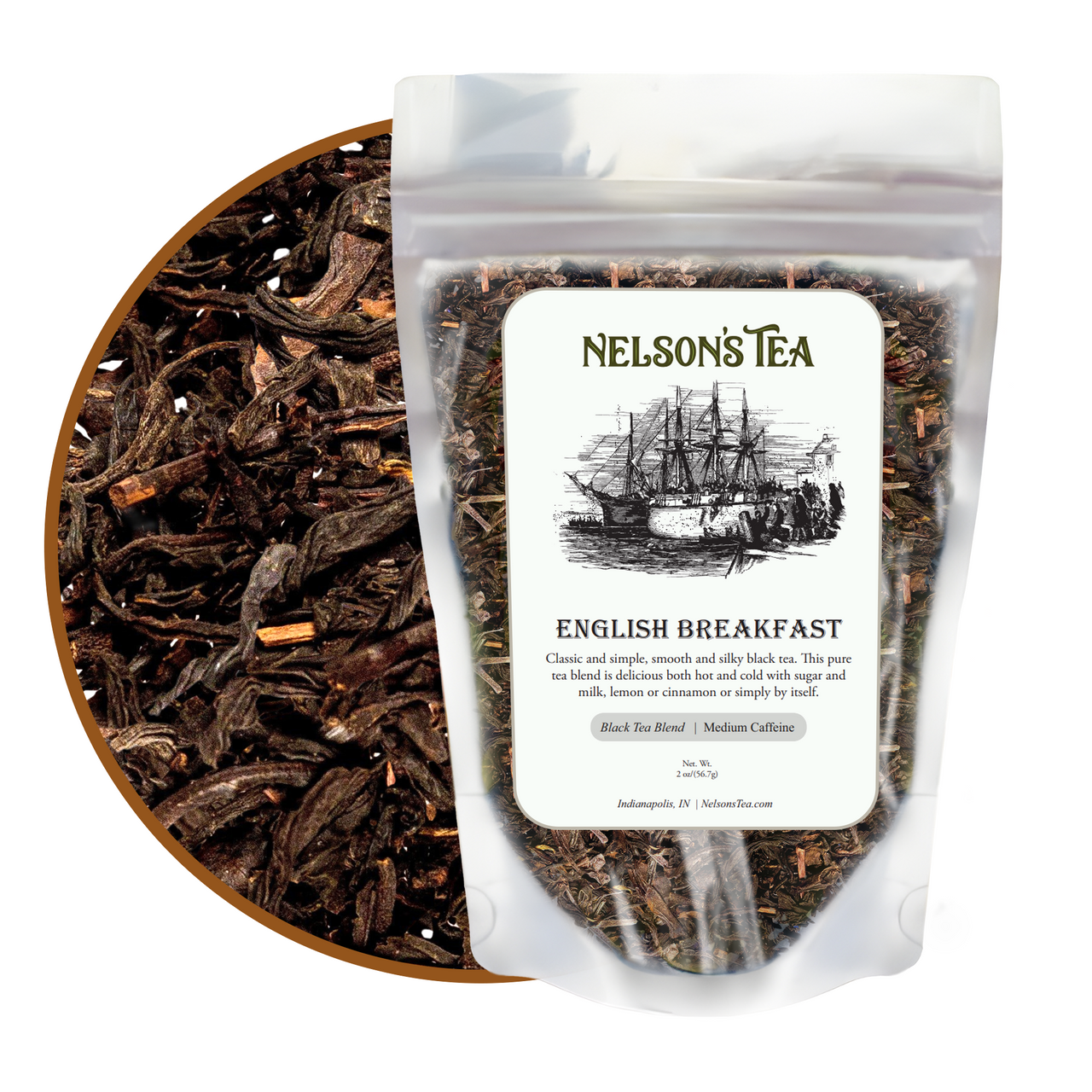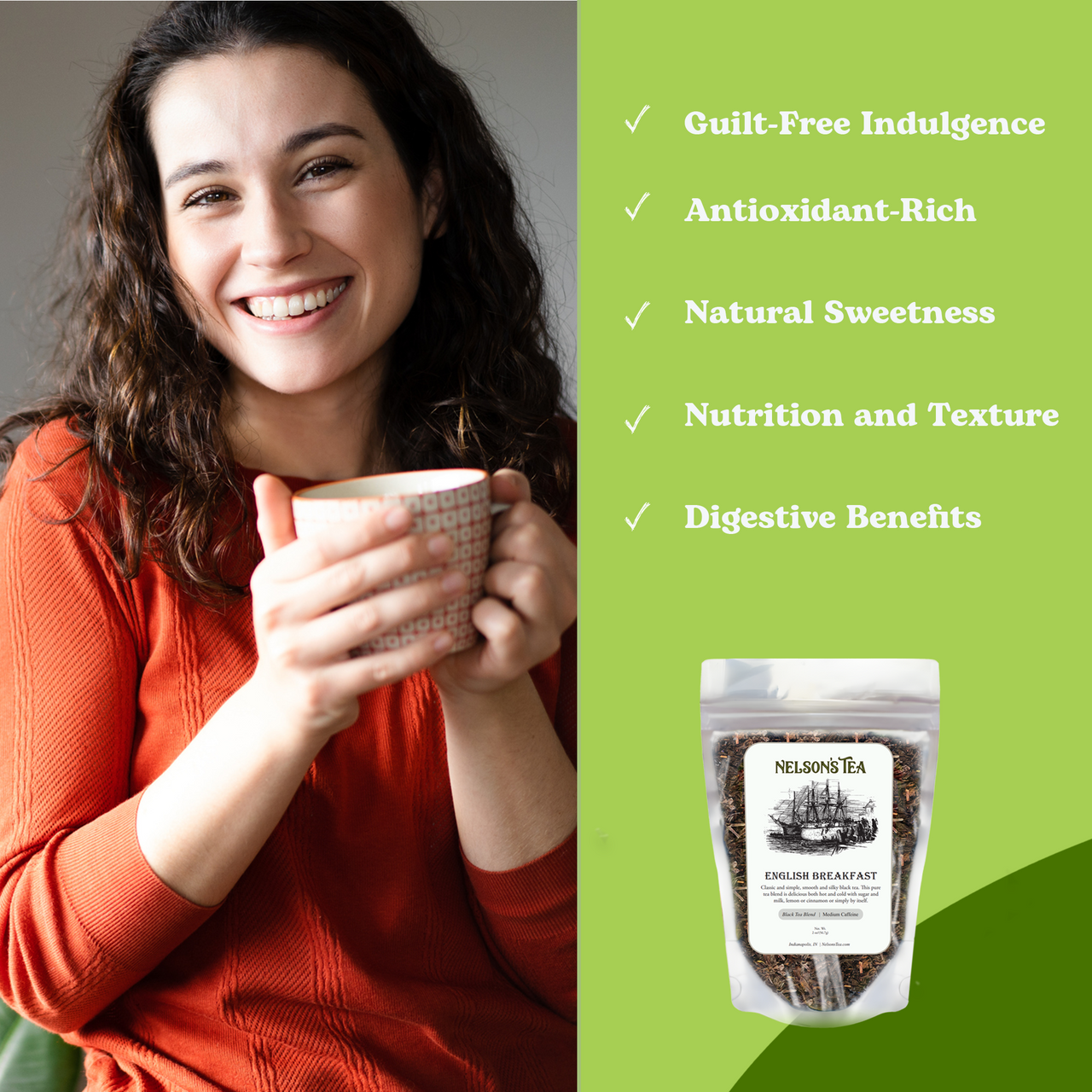
There’s something about starting your morning with a bold, comforting cup of tea that just feels right. And when it comes to the ultimate morning brew, English breakfast tea takes the crown. It's not just tea — it’s tradition, energy, flavor, and a whole vibe.
From what makes this tea special to its health benefits and how to enjoy it daily, we’re giving English breakfast its well-deserved moment in the spotlight.
So grab your favorite mug and settle in as we get into the details. Whether you're a lifelong tea drinker or just looking to swap that third cup of coffee for something smoother, this blog’s for you.
What is English Breakfast Tea?
English breakfast tea is a strong, full-bodied black tea blend that’s been fueling mornings for generations. It typically includes a mix of tea leaves from places like Assam, Ceylon, and Kenya. These regions are known for producing teas with bold flavors, rich colors, and a kick that pairs beautifully with breakfast foods.
Unlike lighter teas, English breakfast is built to handle milk, sugar, or honey without losing its personality. That’s part of why it’s so popular. You can enjoy it plain or customize it however you like. And while the name might say “breakfast,” don’t let that stop you from drinking it any time of day — just not late in the evening due to the caffeine.
English Breakfast Tea: Flavor Profile and Brewing Tips
Let’s talk taste. English breakfast tea is malty, slightly sweet, and a little brisk. It’s smooth enough for everyday sipping but strong enough to give you a real wake-up call.
To brew the best cup, use about one teaspoon of loose-leaf tea per 8-ounce cup. Bring your water just to a boil (around 200°F), pour it over the leaves, and let it steep for 3 to 5 minutes. Want it stronger? Let it sit a bit longer. Would you prefer it lighter? Pull it early.
You can drink it black, but many people add milk and sugar. Others squeeze in a bit of lemon. No matter how you take it, having the right tea accessories, like a quality strainer or a proper teapot, makes a big difference.
A Brief History of English Breakfast Tea
English breakfast tea dates back to the 19th century, when strong black teas started gaining popularity in Britain. It was originally blended to pair with hearty morning meals: think eggs, sausage, toast, and more. People needed something bold enough to stand up to all that richness, and English breakfast delivered.
Some say Queen Victoria helped bring it into the spotlight when she fell in love with it during her travels. Whatever the true origin, it quickly became a household staple in the UK and eventually around the world.
Why Is It Called English Breakfast Tea?
It’s all in the name — this tea was designed to be enjoyed with a traditional English breakfast. The blend’s robust flavor complements savory and rich foods, making it an ideal match for a big morning spread. Over time, the name stuck, and even though it’s no longer just for breakfast, the title remains a nod to its roots.
Today, English breakfast tea isn’t limited to English tables or traditional meals. It’s become a global favorite for anyone who wants a strong, satisfying cup of tea.
What Makes English Breakfast Tea a Classic?
Trends come and go, but English breakfast tea stays strong, literally and figuratively. It’s not just a tea type; it’s a staple. It's the kind of brew that’s equally at home in your favorite chipped mug or poured into fine china at high tea.
What makes it a classic? It delivers every single time. Bold flavor, smooth finish, and the kind of consistency you can count on whether it’s 6 a.m. or mid-afternoon.
It’s also a shape-shifter in the best way. Want it black and brisk? Done. Would you prefer it mellowed out with milk and honey? Still delicious. A splash of lemon? Absolutely. English breakfast can handle it all without losing its character.
Rooted in tradition but made for modern life, it’s the tea you reach for when you need comfort, clarity, or just something reliably great in your day. That’s what keeps tea drinkers coming back. And that’s what makes English breakfast tea a true classic.
Pairing English Breakfast Tea With Food
Want to make your cup of tea even better? Try pairing it with the right food. Because of its strength, English breakfast tea works with both sweet and savory dishes. Here are a few tasty pairings:
- Buttered toast or scones with jam
- Scrambled eggs or quiche
- Banana bread or muffins
- Savory breakfast sandwiches or avocado toast
If you're having a slow morning, make it special with a little food and a proper pot of tea. It’s a simple way to bring joy and balance to your routine.

Health Benefits of Drinking English Breakfast Tea
Sure, it tastes great — but English breakfast tea also comes with some serious health perks. For one, it’s packed with antioxidants, which may help protect your cells from damage and reduce inflammation.
If you're looking for a way to feel energized and balanced while still enjoying something warm and comforting, this tea checks all the boxes. The health benefits of this breakfast tea go well beyond the morning boost.
These are just a few of the potential benefits of drinking English breakfast tea:
- Supports cardiovascular health 
- May help with lowering blood pressure 
- Improves mental alertness and focus 
- Provides a gentle caffeine boost 
- Boosts antioxidants to protect against free radicals 
- Promotes a sense of well-being 
- May support gut health and digestion 
- Can reduce inflammation throughout the body 
- May assist in maintaining healthy cholesterol levels 
Adding a cup (or two) to your daily routine could be a simple way to support your long-term health while treating your taste buds at the same time.
How to Enjoy English Breakfast Tea in Your Routine
One of the best things about English breakfast tea is how easy it is to fit into your day. You can make it part of your morning ritual, sip it during a mid-morning break, or even use it as an afternoon pick-me-up when the coffee jitters start to creep in.
You don’t need a big routine to enjoy it, either. Just steep, sip, and go. Or turn it into something special with a journal, a window view, or a few quiet moments before the day takes over.
Whether you’re at home, in the office, or on the road, this great tea fits your lifestyle.
Loose-Leaf vs. Bagged English Breakfast Tea: Why It Matters
There’s no denying that tea bags are convenient. However, if you want the best English breakfast tea experience, loose-leaf tea is the way to go.
Loose-leaf gives you fuller flavor, more aroma, and higher quality tea leaves. You’re getting the whole leaf, not the crushed bits and dust that often end up in bags. That means a richer cup with more complexity and more benefits.
It also gives you more control. You can adjust the strength to your liking and enjoy a fresher brew every time. When you invest in premium teas, you’re investing in your enjoyment and your health.
Can You Drink English Breakfast Tea All Day?
Yes, you can drink English breakfast tea all day. But since it does contain caffeine, it’s best enjoyed earlier in the day if you're sensitive. A cup in the morning and another in the early afternoon is an outstanding balance.
That said, it’s a much gentler source of caffeine than coffee. Many people find it gives them a smooth, sustained boost without the crash. So, if you’re looking to cut back on espresso without giving up energy entirely, this tea might be your new best friend.
Sip Boldly, Live Fully
English breakfast tea is more than a drink — it’s a ritual, a moment of calm, and a flavorful way to care for your body and mind. With a bold taste, a rich history, and health benefits that go beyond the cup, it’s no wonder this tea has stayed in the spotlight for so long.
If you’re ready to upgrade your tea routine, explore the English breakfast tea offers from Nelson’s Tea. Their loose-leaf tea options are made from high-quality tea leaves, crafted in small batches, and designed to give you that perfect sip every time.
Whether you’re new to the tea world or already a loyal fan, Nelson’s Tea makes it easy to enjoy premium teas the way they were meant to be enjoyed.
These statements have not been evaluated by the Food and Drug Administration. This product is not intended to diagnose, treat, cure, or prevent any disease.

